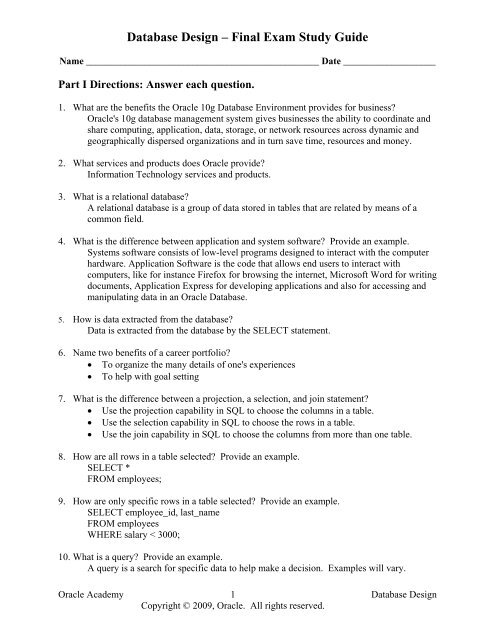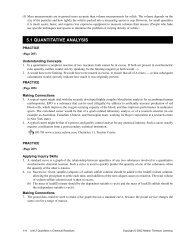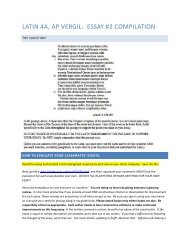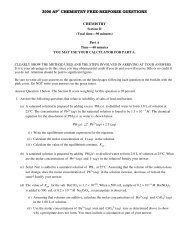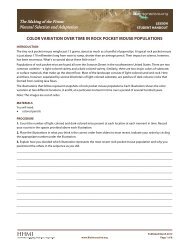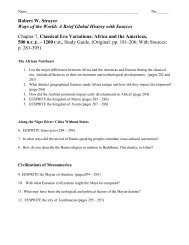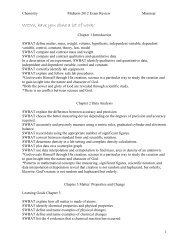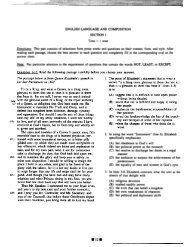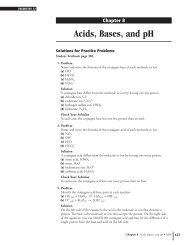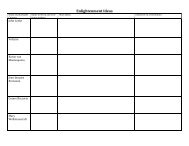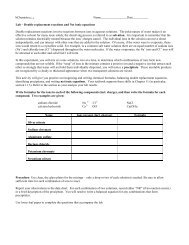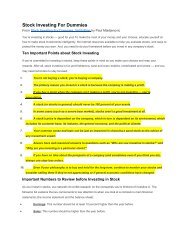Database Design â Final Exam Study Guide - Quia
Database Design â Final Exam Study Guide - Quia
Database Design â Final Exam Study Guide - Quia
You also want an ePaper? Increase the reach of your titles
YUMPU automatically turns print PDFs into web optimized ePapers that Google loves.
<strong>Database</strong> <strong>Design</strong> – <strong>Final</strong> <strong>Exam</strong> <strong>Study</strong> <strong>Guide</strong><br />
Name ________________________________________________ Date ___________________<br />
Part I Directions: Answer each question.<br />
1. What are the benefits the Oracle 10g <strong>Database</strong> Environment provides for business?<br />
Oracle's 10g database management system gives businesses the ability to coordinate and<br />
share computing, application, data, storage, or network resources across dynamic and<br />
geographically dispersed organizations and in turn save time, resources and money.<br />
2. What services and products does Oracle provide?<br />
Information Technology services and products.<br />
3. What is a relational database?<br />
A relational database is a group of data stored in tables that are related by means of a<br />
common field.<br />
4. What is the difference between application and system software? Provide an example.<br />
Systems software consists of low-level programs designed to interact with the computer<br />
hardware. Application Software is the code that allows end users to interact with<br />
computers, like for instance Firefox for browsing the internet, Microsoft Word for writing<br />
documents, Application Express for developing applications and also for accessing and<br />
manipulating data in an Oracle <strong>Database</strong>.<br />
5. How is data extracted from the database?<br />
Data is extracted from the database by the SELECT statement.<br />
6. Name two benefits of a career portfolio?<br />
• To organize the many details of one's experiences<br />
• To help with goal setting<br />
7. What is the difference between a projection, a selection, and join statement?<br />
• Use the projection capability in SQL to choose the columns in a table.<br />
• Use the selection capability in SQL to choose the rows in a table.<br />
• Use the join capability in SQL to choose the columns from more than one table.<br />
8. How are all rows in a table selected? Provide an example.<br />
SELECT *<br />
FROM employees;<br />
9. How are only specific rows in a table selected? Provide an example.<br />
SELECT employee_id, last_name<br />
FROM employees<br />
WHERE salary < 3000;<br />
10. What is a query? Provide an example.<br />
A query is a search for specific data to help make a decision. <strong>Exam</strong>ples will vary.<br />
Oracle Academy 1 <strong>Database</strong> <strong>Design</strong><br />
Copyright © 2009, Oracle. All rights reserved.
<strong>Database</strong> <strong>Design</strong> – <strong>Final</strong> <strong>Exam</strong> <strong>Study</strong> <strong>Guide</strong><br />
Name ________________________________________________ Date ___________________<br />
11. Give an example of a keyword.<br />
SELECT<br />
12. Give an example of a clause.<br />
FROM employees;<br />
13. Give an example of a statement.<br />
SELECT employee_id, last_name<br />
FROM employees;<br />
14. What symbol designates all columns select in a SQL query?<br />
* asterisk<br />
15. What keyword suppresses duplicates and why would there be a need to suppress duplicates?<br />
The DISTINCT keyword suppresses data duplication. <strong>Exam</strong>ple: to get a count of the<br />
departments being used.<br />
16. What clause specifies the table containing the columns?<br />
FROM<br />
17. How do you tell a row from a column?<br />
• A row is left to right and a column is top to bottom.<br />
• A row holds an individual set of data and a column holds a group of the same data.<br />
18. What is a database field?<br />
A database field is where a row and a column meet.<br />
19. What is the difference between a primary key and foreign key column?<br />
• Primary key is a unique identifier for each row.<br />
• Foreign key is a column(s) that refers to a primary key column(s) in another table.<br />
20. How does the database application know what table to select to retrieve data?<br />
The FROM clause specifies the table.<br />
21. What are the five simple guidelines, you use to construct valid SQL statements?<br />
• SQL statements are not case sensitive.<br />
• SQL statements can be on one or more lines.<br />
• Keywords cannot be abbreviated or split across lines.<br />
• Clauses are usually placed on separate lines.<br />
• Indents are used to enhance readability.<br />
22. What is a column alias?<br />
A column alias is a new heading/title for a column in a SQL statement.<br />
Oracle Academy 2 <strong>Database</strong> <strong>Design</strong><br />
Copyright © 2009, Oracle. All rights reserved.
<strong>Database</strong> <strong>Design</strong> – <strong>Final</strong> <strong>Exam</strong> <strong>Study</strong> <strong>Guide</strong><br />
Name ________________________________________________ Date ___________________<br />
23. What are the rules for using a column alias?<br />
There are several rules when using column aliases to format output. A column alias:<br />
o Renames a column heading<br />
o Is useful with calculations<br />
o Immediately follows the column name<br />
o May have the optional AS keyword between the column name and alias<br />
o Requires double quotation marks if the alias contains spaces, special characters or<br />
is case sensitive (what does case sensitive mean – add to teacher notes for this<br />
page).<br />
There is one other restriction when using column aliases - you cannot use them in the<br />
WHERE clause.<br />
24. Why use a column alias?<br />
The selected column name is used as the heading/title for a column in a SQL statement.<br />
This heading (column name) may not be descriptive or may be difficult to understand or<br />
may be to long, so change the column heading by using a column alias.<br />
25. Where are columns named in a SQL query? Provide an example.<br />
The name of the columns displayed will be the same as the column names in the table or<br />
a name showing a query operation such as 12*(SALARY + 100).<br />
26. What is an arithmetic expression? Provide an example.<br />
A numerical sentence.<br />
salary * 3 / 7<br />
27. What are the arithmetic operators? Provide an example.<br />
Addition, subtraction, multiplication, division +, -, *, /<br />
28. How does the database application choose what arithmetic operations to do first?<br />
Please Excuse My Dear Aunt Sally.<br />
Parenthesis, Exponents, Multiplication and Division, Addition and Subtraction working<br />
from left to right.<br />
29. What overrides the rules of precedence?<br />
You can override the rules of precedence by using parentheses to specify the order in<br />
which operators are executed.<br />
30. What exactly is a null value?<br />
A null value is a value that is unavailable, unassigned, unknown, or inapplicable.<br />
31. What results when a null is used in a calculation?<br />
If any value in an arithmetic expression is null, the result is null.<br />
Oracle Academy 3 <strong>Database</strong> <strong>Design</strong><br />
Copyright © 2009, Oracle. All rights reserved.
<strong>Database</strong> <strong>Design</strong> – <strong>Final</strong> <strong>Exam</strong> <strong>Study</strong> <strong>Guide</strong><br />
Name ________________________________________________ Date ___________________<br />
32. If a column alias is wanted a certain way, it should be enclosed by?<br />
By default, alias headings appear in uppercase. If the alias contains spaces or special<br />
characters, or is case sensitive, enclose the alias in double quotation marks (“ ”).<br />
33. How does the concatenation operator function?<br />
The concatenation operator can link columns to other columns, arithmetic expressions, or<br />
constant values to create a character expression. Columns on either side of the operator<br />
are combined to make a single output column.<br />
34. What is a literal value and what are literal values enclosed by?<br />
A literal value is a character, a number, or a date included in the SELECT list.<br />
Literal values are enclosed in single (‘) quotation marks.<br />
35. What command displays the structure of a table?<br />
The DESC command displays the structure of a table.<br />
36. List and define the four data types?<br />
CHAR – fixed-length character value<br />
NUMBER – number value<br />
VARCHAR2 – variable-length character value<br />
DATE – Date and time value<br />
37. When a column is defined as NOT NULL, what does this represent to the SQL programmer?<br />
NOT NULL indicates that a column must contain data.<br />
38. Create a query that shows the structure of the EMPLOYEES table.<br />
DESCRIBE employees;<br />
39. Create a query to display the last name, job id, hire date and employee number for each<br />
employee. Label the column headings.<br />
SELECT employee_id “Employee Number”, last_name “Last Name”, job_id “Job Title”,<br />
hire_date “Hire Date”<br />
FROM employees;<br />
Part II Directions: Answer each question<br />
1. What clause restricts rows used by a SQL query?<br />
The WHERE clause<br />
2. What is a condition?<br />
A proposition on which another proposition depends; is composed of column names,<br />
expressions, constants and a comparison operator<br />
Oracle Academy 4 <strong>Database</strong> <strong>Design</strong><br />
Copyright © 2009, Oracle. All rights reserved.
<strong>Database</strong> <strong>Design</strong> – <strong>Final</strong> <strong>Exam</strong> <strong>Study</strong> <strong>Guide</strong><br />
Name ________________________________________________ Date ___________________<br />
3. The WHERE clause can compare values. It consists of which three elements?<br />
• column name<br />
• comparison condition<br />
• column name, constant, or list of values<br />
4. Which operator would you use to make the following comparisons:<br />
a. Greater than or equal to _________>=<br />
b. Equal to _________=<br />
c. Less than _________<<br />
d. Less than or equal to _________
<strong>Database</strong> <strong>Design</strong> – <strong>Final</strong> <strong>Exam</strong> <strong>Study</strong> <strong>Guide</strong><br />
Name ________________________________________________ Date ___________________<br />
14. Why does the WHERE clause use IS NULL when searching for a null condition?<br />
The IS NULL condition checks for nulls – since a null value means the value is<br />
unavailable, unassigned…. so, you cannot test with the = because a null cannot be equal<br />
to any value.<br />
15. Why does the WHERE clause use IS NOT NULL when searching for a not null condition?<br />
The IS NOT NULL condition checks for not nulls – values that are assigned, are<br />
available ignoring the null values.<br />
16. List and describe the three logical operators.<br />
• AND – returns true if both conditions are true<br />
• OR – returns true if either condition is true<br />
• NOT – returns true if the following condition is false<br />
17. What logical operator is calculated first?<br />
NOT, then AND, then OR<br />
18. What do you do to override the default order of the rules of precedence?<br />
Use parentheses.<br />
19. What clause is used to sort the rows?<br />
ORDER BY clause<br />
20. Are all character searches case sensitive? True/False<br />
TRUE<br />
21. The OR conditional operator requires either condition to be true. True/False<br />
TRUE<br />
22. The AND conditional operator requires either condition to be true. True/False<br />
FALSE<br />
23. The NOT conditional operator reverses the condition. True/False<br />
TRUE<br />
24. What is the default sort order of the rows of data?<br />
ASC – ascending order<br />
25. Where in a SELECT statement does the ORDER BY clause go? Give an example.<br />
Last line of a SELECT statement.<br />
SELECT * FROM employees ORDER BY 1;<br />
26. If the ORDER BY clause is not used how is the data displayed?<br />
The sort order is undefined.<br />
Oracle Academy 6 <strong>Database</strong> <strong>Design</strong><br />
Copyright © 2009, Oracle. All rights reserved.
<strong>Database</strong> <strong>Design</strong> – <strong>Final</strong> <strong>Exam</strong> <strong>Study</strong> <strong>Guide</strong><br />
Name ________________________________________________ Date ___________________<br />
27. What three ways can the sort condition of the ORDER BY clause be written? Give an<br />
example of each.<br />
An expression, an alias, column position<br />
SELECT employee_id, last_name, salary ‘SAL’<br />
FROM employees<br />
ORDER BY employee_id, ‘SAL’, 2;<br />
28. Create a query to display the last name, salary and commission for all employees who earn a<br />
commission. Place the results in descending order by salary. Label the column headings.<br />
SELECT last_name, salary, commission_pct<br />
FROM employees<br />
WHERE commission_pct IS NOT NULL;<br />
29. Create a query to display the employees’ last name, job id, start date of employees hired<br />
between February 11, 1997 and May 5, 1998. Place the results in order by start date. Label<br />
the column headings.<br />
SELECT last_name “Last Name”, job_id “Job Title”, hire_date “Start Date”<br />
FROM employees<br />
WHERE hire_date BETWEEN ’11-FEB-97’ AND ’05-MAY-98’<br />
ORDER BY hire_date;<br />
30. Create a query to display all the information about employee King.<br />
SELECT *<br />
FROM employees<br />
WHERE last_name LIKE ‘King’;<br />
31. Create a query to display the last names of all employees where the third letter of the last<br />
name is ‘k’ and who have an ‘a’ in their last name.<br />
SELECT last_name<br />
FROM employees<br />
WHERE last_name LIKE ‘__k%’<br />
AND last_name LIKE ‘%a%’;<br />
Part III Directions: Answer each question.<br />
1. Describe the difference between single-row functions and multi-row functions.<br />
• Single row functions operate on single rows only and return one result per row.<br />
• Multiple row functions can manipulate groups of rows to give one result per group of<br />
rows.<br />
2. Think of the calculation (sal * 12) to view the annual salary of all employees, what concepts<br />
does it reinforce?<br />
Order of precedence / order of operations<br />
Oracle Academy 7 <strong>Database</strong> <strong>Design</strong><br />
Copyright © 2009, Oracle. All rights reserved.
<strong>Database</strong> <strong>Design</strong> – <strong>Final</strong> <strong>Exam</strong> <strong>Study</strong> <strong>Guide</strong><br />
Name ________________________________________________ Date ___________________<br />
3. Name all of the character manipulation functions.<br />
• Case-Manipulation Functions - LOWER, UPPER, INITCAP<br />
• Character-Manipulation Functions - CONCAT, SUBSTR, LENGTH, INSTR,<br />
LPAD,RPAD, TRIM, REPLACE<br />
4. Name the “general” single row functions.<br />
nvl, nvl2, nullif, coalesce<br />
5. What does the Case Conversion “INITCAP” perform?<br />
INITCAP converts alpha character values to uppercase for the first letter of each word,<br />
all other letters are lowercase.<br />
6. What is the purpose of using the CASE conversion UPPER?<br />
To match the query case with the case of the data in the database.<br />
7. Suppose you begin working for a company where all the employee names had been entered<br />
with only a first initial and last name, all in the same field. As a competent data modeler, you<br />
know that first names should be in a column by themselves. How could you remove the first<br />
initial from each name with one command?<br />
Use the SUBSTR character-manipulation function to extract the first name from the<br />
whole name.<br />
8. How could you get rid of any extra spaces accidentally entered by the data entry clerk when<br />
names were entered?<br />
Use CONCAT TO join the names together.<br />
9. What keyword would be used to find the longest name in the database?<br />
LENGTH<br />
10. Why would we want to know the longest name?<br />
Possible Answer: To determine how much space is needed for a column.<br />
11. Describe the difference between ROUND, TRUNC and MOD.<br />
ROUND is used to round the decimal places to an 'n' decimal place.<br />
TRUNC cuts off the values at a specified decimal place, no rounding is done.<br />
MOD is the value of the remainder after division.<br />
12. What is the dual table?<br />
The dual table is a "dummy" table of one row with one column used to do SELECT<br />
statements that have no underlying tables.<br />
13. What is SYSDATE?<br />
SYSDATE is the current date and time of the database server.<br />
Oracle Academy 8 <strong>Database</strong> <strong>Design</strong><br />
Copyright © 2009, Oracle. All rights reserved.
<strong>Database</strong> <strong>Design</strong> – <strong>Final</strong> <strong>Exam</strong> <strong>Study</strong> <strong>Guide</strong><br />
Name ________________________________________________ Date ___________________<br />
14. What would<br />
SELECT sysdate<br />
FROM dual;<br />
Return?<br />
Today's date and time from the database server.<br />
15. Why is the dual table needed?<br />
Dual is needed to perform SELECT operations not based on existing tables.<br />
16. What are three usages of Arithmetic with dates?<br />
date + number<br />
date - number<br />
date - date<br />
Oracle Academy 9 <strong>Database</strong> <strong>Design</strong><br />
Copyright © 2009, Oracle. All rights reserved.


